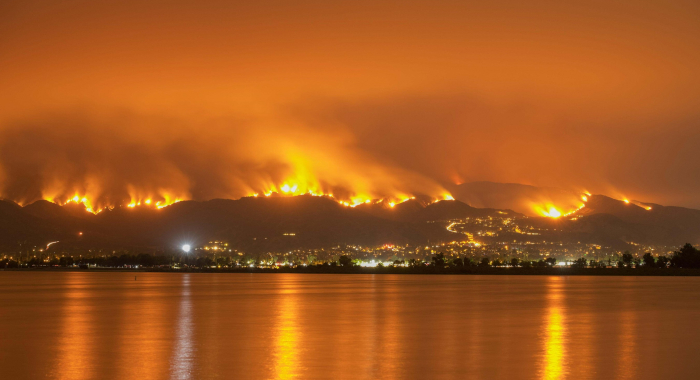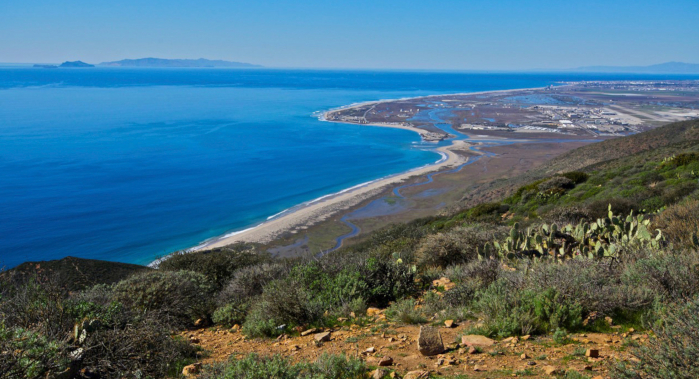Systematic, science-based conservation planning is a hallmark of the Conservancy. For biodiversity to thrive, habitats need to be protected, enhanced, or restored not just in the still wild places on the planet but also where people live and make their livelihoods.
Multi-disciplinary planning can help elucidate where the highest priority places are and what needs to happen there – and inform tradeoffs between conservation and other societal values.


Benjamin M. Sleeter, David C. Marvin, D. Richard Cameron, Paul C. Selmants, A.LeRoy Westerling, Jason Kreitler, Colin J. Daniel, Jinxun Liu, Tamara S. Wilson
Gorm E. Shackelford, Rodd Kelsey, William J. Sutherland, Christina M. Kennedy, Stephen A. Wood, Sasha Gennet, Daniel S. Karp, Claire Kremen, Nathaniel E. Seavy, Julie A. Jedlicka, Kelly Gravuer, Sara M. Kross, Deborah A. Bossio, Andrés Muñoz-Sáez, Deirdre G. LaHue, Kelly Garbach, Lawrence D. Ford, Mark Felice, Mark D. Reynolds, Devii R. Rao, Kathleen Boomer, Gretchen LeBuhn, Lynn V. Dicks
Agricultural management practices impacts not only on crops and livestock, but also soil health, water quality, wildlife, and ecosystem services. There is abundant, but disconnected,…Heather Tallis, Katharine Kreis, Lydia Olander, Claudia Ringler, David Ameyaw, Mark E Borsuk, Diana Fletschner, Edward Game,, Daniel O Gilligan, Marc Jeuland, Gina Kennedy, Yuta J Masuda, Sumi Mehta, Nicholas Miller, Megan Parker, Carmel Pollino, Julie Rajaratnam, David Wilkie, Wei Zhang, Selena Ahmed, Oluyede C Ajayi, Harold Alderman, George Arhonditsis, Ines Azevedo, Ruchi Badola, Rob Bailis, Patricia Balvanera, Emily Barbour, Mark Bardini, David N Barton, Jill Baumgartner, Tim G Benton, Emily Bobrow, Deborah Bossio, Ann Bostrom, Ademola Braimoh, Eduardo Brondizio, Joe Brown, Benjamin P Bryant, Ryan SD Calder, Becky Chaplin-Kramer, Alison Cullen, Nicole DeMello, Katherine L Dickinson, Kristie L Ebi, Heather E Eves, Jessica Fanzo, Paul J Ferraro, Brendan Fisher, Edward A Frongillo, Gillian Galford, Dennis Garrity, Lydiah Gatere, Andrew P Grieshop, Nicola J Grigg, Craig Groves, Mary Kay Gugerty, Michael Hamm, Xiaoyue Hou, Cindy Huang, Marc Imhoff, Darby Jack, Andrew D Jones, Rodd Kelsey, Monica Kothari, Ritesh Kumar, Carl Lachat, Ashley Larsen, Mark Lawrence, Fabrice DeClerck, Phillip S Levin, Edward Mabaya, Jacqueline MacDonald Gibson, Robert I McDonald, Georgina Mace, Ricardo Maertens, Dorothy I Mangale, Robin Martino, Sara Mason, Lyla Mehta, Ruth Meinzen-Dick, Barbara Merz, Siwa Msangi, Grant Murray, Kris A Murray, Celeste E Naude, Nathaniel K Newlands, Ephraim Nkonya, Amber Peterman, Tricia Petruney, Hugh Possingham, Jyotsna Puri, Roseline Remans, Lisa Remlinger, Taylor H Ricketts, Bedilu Reta, Brian E Robinson, Dilys Roe, Joshua Rosenthal, Guofeng Shen, Drew Shindell, Ben Stewart-Koster, Terry Sunderland, William J Sutherland, Josh Tewksbury, Heather Wasser, Stephanie Wear, Chris Webb, Dale Whittington, Marit Wilkerson, Heidi Wittmer, Benjamin DK Wood, Stephen Wood,, Joyce Wu, Gautam Yadama and Stephanie Zobrist
Although environmental conservation, human health, and sustainable development challenges are interconnected, approaches to these challenges and the evidence used remain disconnected. Creating…Sean P. Fitzgerald , Hunter S. Lenihan, Jono R. Wilson, Carolynn S. Culver, Matthew Potoski
This paper highlights the benefits of collaborative fisheries research in the management of wild capture fisheries. The authors teamed up with commercial fishermen in the southern California…Laura S. Brophy, Correigh M. Greene, Van C. Hare, Brett Holycross, Andy Lanier, Walter N. Heady, Kevin O’Connor, Hiroo Imaki, Tanya Haddad, Randy Dana
The authors of this study generated new maps of current and historical tidal wetlands in 450 estuaries throughout Washington, Oregon, and California. Using laser-mapping technology known as LIDAR…Summary available in English and Spanish.
Parker SS, Randall JM, Pauly GB, Li E, Brown BV, Cohen BS
This report is a product of the Biodiversity Analysis in Los Angeles (BAILA) project. It provides details on why we conducted our analysis, how the partnership between the Museum and the Conservancy…Grace C. Wu, Emily Leslie, Douglas Allen, Oluwafemi Sawyerr, D. Richard Cameron, Erica Brand, Brian Cohen, Marcela Ochoa, Arne Olson
California has ambitious climate and energy policies that call for the development of significant amounts of new zero-carbon energy by midcentury. The Power of Place study looks at multiple pathways…Enjie Li, Sophie S. Parker, Gregory B. Pauly, John M. Randall, Brian V. Brown, Brian S. Cohen
This dataset is a product of the Biodiversity Analysis in Los Angeles (BAILA) project, and demonstrates a new way to evaluate urban biogeography—patterns in the distribution of species across…Carrie Schloss, Liz O'Donoghue
Enjie Li, Sophie S. Parker, Gregory B. Pauly, John M. Randall, Brian V. Brown, Brian S. Cohen
This paper presents a new way to evaluate urban biogeography—patterns in the distribution of species across urban areas. The authors developed a hierarchical, quantitative method for classifying…David Edelson, Angel Hertslet
There is an urgent need to increase the pace and scale of forest restoration in the Sierra Nevada and throughout the West to reduce the risk of high-severity wildfire and promote more resilient forest…Prepared by Anchor QEA, LLC (John Ferguson, Elizabeth Greene, and Michelle L. Ratliff), Contributors and Participants: John Cain, Jon Rosenfield, Alison Weber-Stover, Stephen Louie, John Shelton, Tim Heyne, Brian Ellrott, Sierra Franks, Monica Gutierrez, Rhonda Reed, David Swank, Steve Edmundson, Katie Schmidt, Rachel Johnson, Jeanette Howard, Julie Zimmerman, Chris Carr, Daniel Worth, Rene Henery, Ron Yoshiyama, Joshua Israel, Paul Cadrett, Ramon Martin, and J.D. Wikert
Also view Appendix A: Stanislaus Survival Model and and other report Appendices.Carrie Schloss, Dick Cameron, Nathaniel Rindlaub, Connor Shank
This interactive, web-based tour provides an accessible introduction to The Nature Conservancy’s analysis of wildlife movement routes for climate adaptation in California. Viewing these pathways…Brett G. Dickson, Christine M. Albano, Ranjan Anantharaman, Paul Beier, Joe Fargione, Tabitha A. Graves, Miranda E. Gray, Kimberly R. Hall, Josh J. Lawler, Paul B. Leonard, Caitlin E. Littlefield, Meredith L. McClure, John Novembre, Carrie A. Schloss, Nathan H. Schumaker, Viral B. Shah, David M. Theobald
The authors explore the impact that Brad McRae’s development of circuit theory and the associated software, Circuitscape, have had, and continue to have, on connectivity science and…Annika T. H. Keeley, Galli Basson, D. Richard Cameron, Nicole E. Heller, Patrick R. Huber, Carrie A. Schloss, James H. Thorne, Adina M. Merenlender
Connectivity conservation must move more rapidly from planning to implementation. We provide an evidence‐based solution composed of key elements for successful on‐the‐ground…W. David Shuford, Matthew E. Reiter, Kristin A. Sesser, Catherine M. Hickey, Gregory H. Golet
Agricultural intensification has been a major factor in the loss of global biodiversity. Even so, agricultural landscapes provide important habitat for many bird species, particularly in the Central…Joseph A. E. Stewart, H. Scott Butterfield, Jonathan Q. Richmond, David J. Germano, Michael F. Westphal, Erin N. Tennant, Barry Sinervo
Due to limited water resources, there is a global trend toward the retirement of farmland, especially in the San Joaquin Valley in California where the Sustainable Groundwater Management Act could…Annika T H Keeley, David D Ackerly, D Richard Cameron, Nicole E Heller, Patrick R Huber, Carrie A Schloss, James H Thorne, Adina M Merenlender
As climate change impacts wildlife and plants, species may need to access new habitats. Various approaches exist to plan to climate-driven habitat connectivity needs. We summarize the literature of…